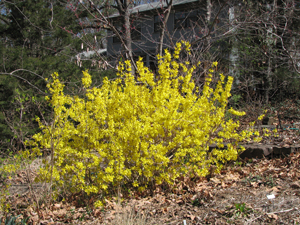Resource Library
Plant of the Week: Phenology
The University of Arkansas System Division of Agriculture does not promote, support or recommend plants featured in "Plant of the Week." Please consult your local Extension office for plants suitable for your region.
Plant of the Week
Phenology

The winter of 2012 was characterized by its brevity, lack of snow and warm conditions. This winter that wasn’t has lead to a spring blooming season that has been characterized as early and congested with lots of plants blooming at the same time. Phenologists, those who study the interaction of weather and climate on repeating biological activities such as flower blooming and insect emergence, have had a busy spring.
In a sense, all gardeners are phenologists because we all keep track of when trees and shrubs can be expected to bloom. Mostly this is an informal mental list that rattles around with the other things we just know, but some of us keep an actual list of blooming dates for one or more plants to use as a kind of biological yardstick to keep track of how the season is progressing.
Tracking flowering dates has many practical applications. This spring marks the 100th anniversary of the gift of 3,000 flowering cherries given to the United States by the emperor of Japan. Over the years, the Washington D.C. Cherry Blossom Festival has become a big event in the capitol and a major focus for tourism. This year’s festival is scheduled for the week of April 20, a date selected because it represents the average peak bloom time for the trees surrounding the Tidal Basin. Unfortunately, this year the trees bloomed three to four weeks early, so the festival organizers will be forced to use the common garden refrain, “you should have seen it a few weeks ago.”
Another application of phenology is to use blooming sequence as an indicator of when an insect pest is likely to emerge, or when a crop should be planted. For example, blooming time for crabapple is a good biological marker for when spring webworms show up in cherry orchards. Or, according to some, you should plant your potatoes when you see the first dandelion bloom of spring. Or, you apply your first spring pre-emergence herbicide application to control summer lawn weeds when forsythia blooms.
Recently researchers have gone back to old blooming date records – for example, Henry David Thoreau tracked blooming dates of a number of plants around Walden Pond – and are comparing old data to modern data as a measure of global warming. In a multiyear Boston area, study researchers have found that most plants bloom about seven days earlier today than they did a century ago.
Over the past 40 years, I’ve kept blooming date records – albeit more sketchy and scattered than I would like – of two different forsythia bushes. Over most of those years, the forsythias reached peak bloom between March 10 and 12. This year it was February 28, the earliest I’ve seen it bloom. I selected forsythia to track because for me it has always represented the boundary marker between winter and spring.
Blooming dates can be predicted mathematically using the growing degree day model. In this calculation, the growing degree days are calculated by averaging the high and low temperature for each day and subtracting the base temperature, which varies with each species but is usually around 50 degrees Fahrenheit. For example, if the daytime high temperature were 65 degrees and the low 41 degrees, the growing degree days would be three for that particular day. These are calculated daily from site temperature data and are accumulated, counting from the average minimum temperature for the winter. For my forsythia blooming occurs when the plants log about 30 growing degree days. Dogwoods require about 110 growing degree days to bloom. Late spring bloomers, such as butterfly bush, require more than 550 growing degree days to bloom.
In a mild winter and an early spring such as we have experienced this year, growing degrees are being accumulated so quickly that the blooming sequence is being compressed dramatically. Early bloomers, such as my forsythia and crocus, bloomed about two weeks ahead of schedule, but late bloomers, primarily because night temperatures were so mild and the number of growing degree days accumulated more quickly, are blooming three or more weeks ahead of schedule.
By: Gerald Klingaman, retired
Retired Extension Horticulturist - Ornamentals
Extension News - March 30, 2012
The University of Arkansas System Division of Agriculture does not maintain lists of retail outlets where these plants can be purchased. Please check your local nursery or other retail outlets to ask about the availability of these plants for your growing area.